|
The Smirle garden
offered its own unique set of options. Shade was no longer the
challenge: rather, now it was a goal. While most of the flowering
plants we value love it, most human beings are learning an excess
carries a warning label! And in addition, we considered ourselves
here for the foreseeable future. It made sense to invest in a
much more permanent hardscape, play out a few more 'dreams', and
to spend much more time in the planning. While the Bruyère
garden was built more or less on a wing and a prayer, we spent
a full year working on a design for the Smirle garden that we
both liked, and could be extended over a three or four year construction
period.
Our starting points were a mature maple, specimen cedar, and French lilac; a gentle slope away from the house; no existing hardscape; and an extremely high water table. The latter proved to be a constant challenge, throughout both the design and construction phases. The area we live in appears to be formerly very swampy, with frequent rock outcroppings . We are very close to the Ottawa River, and our garden a short time ago (in geological terms) was obviously part of the river itself! Designing for a bog was a new challenge for me! For our readers in more equatorial climates, in this area of Canada any substantial hardscape must have concrete footings at least 3.5 - 4 feet deep to avoid frost heaving. Faced with ' the bog', technically the foundations we built should have gone down to bedrock, or at least more stable subsoil.
|
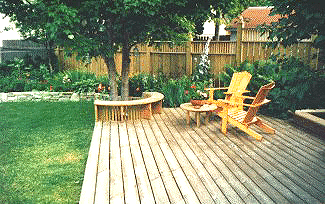 |
The garden is roughly 50 feet by 30 feet - small even by local
standards - and so much of the design work was directed at maximizing
the space usage and creating the impression of more space. Given
the direction of prevailing winds in the summer, and full sun
throughout the day, keeping the space open while still providing
shade was critical. Creating 'garden rooms' had to be limited
to partial screens so as to not block the breeze from the river
- not just to avoid heat build up, but to keep the mosquitoes
moving too! And since we live in a 'small-town' neighborhood,
we wanted fences that would afford some privacy, but not recreate
the Great Wall.
Almost immediately the idea of creating diagonal zones (to pull
the viewer into the space, and increase the sense of the garden's
length) became part of the design. Similarly, we quickly decided
a very large deck built low to the ground would give us access
to the garden immediately after a heavy rain (high water table),
but still give the feeling of being part of the garden. To keep
us in the shade of the existing maple tree this meant building
a deck which partially incorporated the maple, and entirely surrounded
the lilac. Built-in semicircular benches leapt to mind - and the
two basic elements of the garden - long sharp triangles and circles
- were born, as was the first major focal point created by the
hardscape. At first we wanted the wooden fences to be on the north
side and at the end of the garden, with a vegetative screen to
the south side to avoid creating a tunnel effect on our narrow
lot.
|
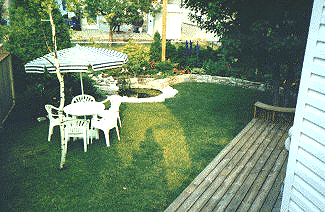 |
|
However, our neighbor in the back had some problems with a fence
between the two properties, and so south and north it had to be.
By necessity, we had to design fences which were much more intricate
than originally envisaged - in essence, a garden feature in and
of themselves. To keep them neighbor friendly!, they are of staggered
heights, so that no matter where we stood we could see through
the vertical 'lattice' portion, but were screened when sitting.
The rest of the design did not come as easily. We had grown to love having the pond close to the deck, but to give it the sunlight required for lily blossoms and to avoid crushing all the hardscape into one small area , it had to go somewhere on the other side and the other end of the garden. A disappointment! until the idea of 'Garry's pond' was born. A simple solution: a second pond built into the back corner of the deck. One pond for fish, and one for Garry! To be honest, when the humidly is 100%, the temperature is 35+ C, and there is not a breeze for miles - its great to crawl into to cool off. Built about a foot higher than the deck, we also dug into the ground to accommodate its four foot depth. Mostly in the shade, and with cool feet, the water stays a pleasant temperature even in the hottest weather! A small filtered fountain was added to create greater interest during spring and fall and to keep the water clear throughout the season.
|
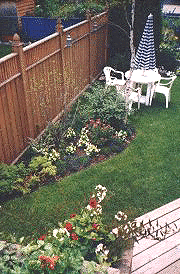
The decision to build stone-walled raised beds came easily -
both as a means to echo the straight and curved lines of the developing
design, but also to avoid some of the drainage problems of the
site. Don't get me wrong, I like bog plants! But
I like sun-loving perennials too - and they hate wet feet! But
most of all, natural stone is a favorite building material. In
this design, however, I opted for a slightly more formal cement-jointed
construction with
|
|
deep foundations. A more naturalistic approach would have jarred
with the hard-edged architectonic features of the deck and fences.
The walls also allowed us to create a second long diagonal section
of grass to echo the lines of the deck By this time the exact
location and shape of the pond were obvious. As I had suspected,
we would have to do some moderate re-working of the slope since
the pond was going to end up in the lowest part of the garden.
However, the work involved was fairly minimal. We had only to
create a slight berm to push the storm water to the other side
of the garden and dig down to ensure that the area in front of
the retaining walls was the lowest part.
top
|
|
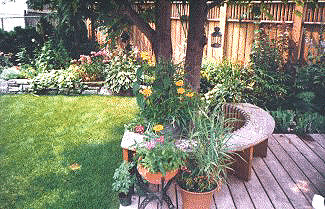 |
|
The goal of creating the right situation for a water fall was
coming together. By extending the retaining wall around the back
of the pond, we had sufficient drop to create the sound level
we wanted, and not enough to disturb the water lilies too much
(they don't like water movement as it tends to keep the upper
surfaces wet and prone to disease). By taking the soil for the
seven foot diameter, four foot deep pond and piling it up behind
the pond and the existing cedar we created a small 'hill' which
proved to be a fairly natural looking route for a small stream
to bring the water in.
The actual look we wanted was quite precise. On a walk the previous
summer in Adirondack National Park in northern New York State
(where my sister lives) we had come across a stream which had
during spring runoffs worn away all the soil leaving only larger
rounded stones. The water ran beneath, not over them leaving the
rocks constantly moist and host to countless mosses and small
ferns. The effect was subtle, and in a man-made garden a highly
plausible means to create a realistic water source.
|
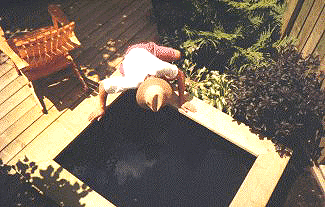 |
|
Of course, constructing the pond came with its utterly unexpected
challenges. In Bruyere we hit a building. In Smirle we hit a natural
spring about three feet down! It may sound ideal, but it wasn't
at all. We didn't really want a 2 - 3 foot drop before the surface
of the pond started - and so... thirty bags of marine cement later
we had suppressed the flow long enough to get the lining and the
water in to separate and equalize the pressure of the two bodies
of water!
What we ended up with was a cement lined pond (including benches
for the plants) covered with a flexible lining. Over kill, unintended
- and I'll let you know as time goes on, how wise! The pump for
the stream by the way is now a small sump pump , replacing the
fancy German model we started with. That one's filtration system
was simply too small to handle this pond (despite what its specs
indicated), but does a fine job in the people pond. We have avoided
a bio-filter, concentrating on the plant and animal life required
to maintain balance.
|
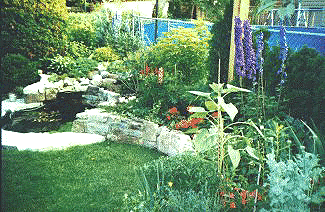 |
The goldfish like it: the large fantail gave birth this summer!
but you do have to accept a few fairly short periods of cloudiness
(early spring, and when the temperature remains above 30C for
longer than a week). By the way, the blue plastic dog screen in
the background belongs to our neighbor. Thankfully it is now gone,
but would have in fact been blocked from our view in a few more
years as the plantings behind the pond grew.
This last summer we continued the design along the south side
of the garden by first digging in underground electrical cables
(finally) to run the pond and outdoor lighting system, and an
elongated semi-circular planting bed (another apple with under
plantings), and the gate from hell. A word to the wise: every
time you design a circular feature in wood you can triple the
amount of time and material required to do the same basic thing
in straight lines. However (perhaps because of it, and its relative
rarity), the look is great. And for this garden feature to announce
the basic forms of the garden was just too much the right thing
to do to carp! (A fish joke?)
|
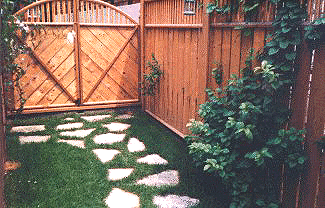 |
|
In the pictures, you can also catch a glimpse of the first of two
built-in box planters which flank the stairway down from the house's
first floor level. As is often the case in climates where basements
are common, the egress from our house is half a storey high! We
chose not to build a substantial deck at that height, but rather
to descend quickly to near ground level. The garden was simply too
small to handle the bulk of a high deck, and my predudice is a garden
of plants, not of hardscape. The planters were added to provide
interest to this functional back cornor of the garden: besides acting
as the stairway's 'railing', they are also built over the entrance
to our garden tool storage area, and beside the narrow garden entrance.
Next year, the final hardscape gets done! The white table and
chairs in the photograph gets replaced by a small circular stone
patio at ground level, a green steel and natural wood table and
chairs (my plan) or another water feature of the Japanese zen
garden variety (Garry's plan). You may have guessed that by year
four of the design implementation, the physical plans have been
tossed in the garbage (literally). The areas left to develop are
small enough to work out in your mind, and the physical presence
of the garden already completed is much stronger than the theoretical
view from four years ago. After that, well we'll probably have
a crisis - we might be able to take a vacation somewhere else
but in our back yard! or we might just move on to the front yard!
|
| |
|
